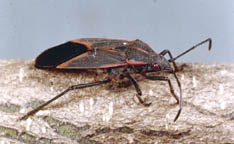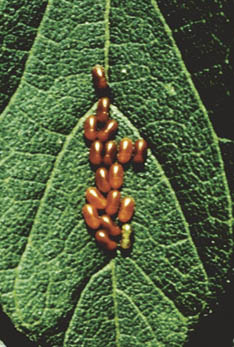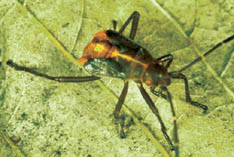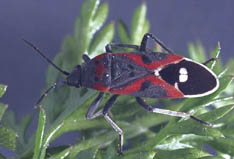by F.B. Peairs* (12/14)
Quick Facts…
- Boxelder bugs are a nuisance in and around homes from fall through early spring.
- The bug overwinters as an adult in protected places such as houses or other buildings.
- Removing female boxelder trees is the most permanent solution to the problem, although this may not be practical or desirable.
- Laundry detergents offer safe, effective control when applied directly to the insects.

Figure 1: Boxelder bug. (Photo courtesy of Clemson University Extension.) |

Figure 2: Boxelder bug eggs on leaf. (Photograph by W. Cranshaw.) |

Figure 3: Boxelder bug nymph. (Photograph by F. Peairs.) |

Figure 4: The small milkweed bug is a seed feeding bug that resembles the boxelder bug. |

Figure 5: Goldenrain tree bug is sometimes confused with the boxelder bug. (Photo by W. Cranshaw.) |
For most people, the boxelder bug needs no introduction. This bug is about 1/2 inch long as an adult, black with three red lines on the thorax (the part just behind the head), a red line along each side, and a diagonal red line on each wing. The immature forms (Figure 3) are smaller and are easily distinguished from the adults (Figure 1) by their red abdomens and lack of wings. The small milkweed bug (Figure 4) and the goldenrain tree bug (Figure 5) are local insects that are sometimes confused with boxelder bugs. Boxelder bugs become a nuisance in and around homes from fall through early spring.
Boxelder bugs feed on a variety of plants, but their favorite food is boxelder seed pods, which are found only on the female boxelder tree, and occasionally maple seeds. These bugs seldom develop in sufficient numbers to be a nuisance unless a female boxelder tree is in the neighborhood.
Overwintering
The boxelder bug overwinters as an adult in protected places such as houses and other buildings, in cracks or crevices in walls, doors, under windows and around foundations, particularly on south and west exposures. In the spring when tree buds open, females lay small, red eggs on leaves (Figure 2) and stones and in cracks and crevices in the bark of female boxelder trees. The eggs later hatch into young nymphs that are wingless and bright red with some black markings. These young bugs usually are found on low vegetation near boxelder trees until seeds are formed on the tree, on which they start to feed.
Boxelder bugs are primarily a nuisance pest, annoying residents by crawling on exteriors and inside dwellings on warm fall and winter days. They also may stain draperies and other light-colored surfaces and produce an unpleasant odor when crushed, but these are not major problems. They do not reproduce during this period. They may attempt to feed on house plants but do not cause any damage. On rare occasions, they have been reported to bite humans.
Types of Control
The most permanent solution to the boxelder bug problem is the removal of female boxelder trees from a neighborhood, although this may not be practical or desirable. Because boxelder bugs usually overwinter near the trees that they feed on, the removal of one or two problem trees may help. Screening or sealing cracks or other entrances into the dwelling is important. Once boxelder bugs have entered the home, control becomes more difficult.
When the bugs begin to congregate on building exteriors, these areas (including all resting and hiding places) may be sprayed with residual insecticides. However, most insecticides registered for treatment of building exteriors are not that effective against boxelder bugs. Laundry detergent and water mixes are cheap, safe and effective when applied directly to boxelder bugs. Drawbacks of detergent sprays are that they will kill only if they contact the insect directly, and they may damage vegetation.
Use a vacuum cleaner to control bugs that have entered the house. Household insecticidal aerosols and many household spray cleaners also are effective when applied directly to individual Insects. These measures provide temporary relief only. Bugs may continue to enter the home as they move about on warmer days throughout the fall, winter and early spring. Nuisance infestations should be finished by late May, as the boxelder bugs have either died or moved back to the host trees.
* Colorado State University Extension entomologist and professor, bioagricultural sciences and pest management. 7/95. Revised 12/14.
Colorado State University, U.S. Department of Agriculture, and Colorado counties cooperating. CSU Extension programs are available to all without discrimination. No endorsement of products mentioned is intended nor is criticism implied of products not mentioned.
Go to top of this page.





